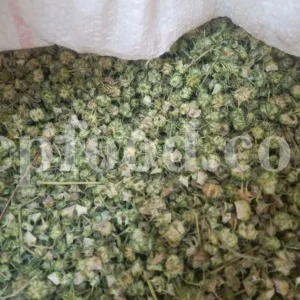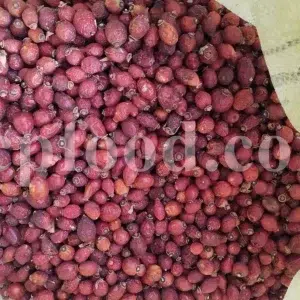Scientific Name: Phyllanthus emblica L.
Synonyms: Emblica officinalis Gaertn.
English Name: Indian Gooseberry
Other Names in English: Emblic, Emblic myrobalan
Family: phyllanthaceae
GENERAL DATA
Plant Parts: Fruit and fruit oil
Cultivation Mode: Wild Collection/ Cultivated
In Manufacturing: Pharmaceutical, food, cosmetics, haircare, skincare, confectionery, alcoholic drink, non-alcoholic drink, spice, oil, perfumery, jam, extract, herbal tea, vinegar, pickles, compote, hair color, cloth dyeing
🌿 Industries That Use Amla Fruit (Phyllanthus emblica L.)
Amla, also known as Indian Gooseberry, is a powerful superfruit revered in Ayurvedic, Unani, and Siddha medicine. It is renowned for its incredibly high vitamin C content, potent antioxidants, and rejuvenating properties.
1. Nutraceutical & Dietary Supplement Industry
-
Widely used in capsules, tablets, powders, and extracts.
-
Acts as a natural immune booster due to high ascorbic acid content.
-
Supports liver health, anti-aging, and detoxification.
-
Promotes metabolism regulation and blood sugar control.
-
Rich in polyphenols like emblicanin A & B, gallic acid, and ellagic acid.
2. Pharmaceutical & Herbal Medicine Industry
-
Common ingredient in Ayurvedic formulations like Triphala, Chyawanprash, and Amalaki Rasayana.
-
Known for anti-inflammatory, hepatoprotective, cardioprotective, and gastroprotective effects.
-
Used in cough syrups, liver tonics, and digestive aids.
-
Helps in the management of diabetes, ulcers, hyperacidity, and oxidative stress-related disorders.
3. Cosmetic & Personal Care Industry
-
Added to shampoos, hair oils, face packs, and serums.
-
Strengthens hair roots, prevents premature greying, and supports hair growth.
-
Used in skin formulations for anti-aging, brightening, and hydrating effects.
4. Food & Beverage Industry
-
Consumed fresh, dried, or as candied amla, juice, pickles, and powders.
-
Incorporated into health drinks, functional foods, and herbal teas.
-
Used as a natural preservative due to its high antioxidant potential.
5. Traditional Medicine Systems
-
Ayurveda: Classified as a Rasayana (rejuvenator), balancing all three doshas.
-
Unani & Siddha: Used for its cooling, strengthening, and laxative properties.
-
Prominent in detox and vitality treatments.
🍀 Summary Table
| Feature | Description |
|---|---|
| Common Names | Amla, Indian Gooseberry, Amalaki |
| Scientific Name | Phyllanthus emblica L. (Emblica officinalis Gaertn.) |
| Part Used | Dried or fresh fruit (whole or powdered) |
| Main Uses | Immune support, digestion, hair & skin care |
| Industries | Nutraceutical, Herbal Pharma, Cosmetic, Food & Beverage |
| Traditional Systems | Ayurveda, Unani, Siddha |
| Forms Available | Dried fruit, powder, juice, extract, capsules |
🧪 Key Bioactive Compounds
-
Vitamin C (stabilized by tannins)
-
Emblicanin A & B
-
Gallic acid, ellagic acid, chebulagic acid
-
Flavonoids, alkaloids, tannins
PRODUCT NAME IN DIFFERENT LANGUAGES
Persian Name: آمله/ Ameleh
German Name (Deutschland, Austria, Switzerland): Amlabaum, Amalaki
French Name (France, Belgium, Switzerland, Quebec): Groseille népalaise, Myrobolan emblique, Amla, Groseillier de Ceylan, Groseillier indien
HARVEST CALENDAR
Feb
Mar
Apr
May
Jun
Jul
Aug
Sep
Oct
Nov
Dec
To order Amla Emblica, please contact us.
About Phyllanthus Emblica
Amla is the fruit of a tree whose height reaches 8 meters. The bark of phyllanthus emblica tree is grayish brown and usually branches from near the ground.
The leaves of this tree are compound and include oval, very small and thick leaflets that grow reciprocally without a petiole.
Its flowers are small and yellow, and each one has six elongated oval petals that grow in clusters.
This shrub is distributed in tropical regions from India to southern China.
The fruit of this tree is pale green and yellowish, spherical, the size of a walnut, has sour taste and is acrid. Its fruit shrivels and turns black after drying. Inside this fruit is an almost spherical core, on its surface there are six raised lines and six kernels inside.
The best type is bigger, heavy and yellow. Which is offered fresh (in growing areas) or dry in other areas. Amla is usually soaked in cow’s milk for three days and then washed and dried in order to reduce its bitter taste.
Indian Gooseberry Chemical Constituents
Tannins, phenolic acids, and flavonoids, alkaloids, phytosterols, terpenoids, organic acids, amino acids, and vitamins. Emblicanin A, B, punigluconin, pedunculagin, geranin, isochorylagin, corylagin, chebulanic acid, chebulagate acid, isostrictinin, gallic acid, mucous acid lactone gallate, digalloylglucose, methyl gallate, ethyl error, monogalloyl glucose, putanjivin A, galloil-HHDP-glucose, and elaeocarpusin are hydrolyzed tannins found in P. emblica fruit.
Other bioactive substances include gallic acid, ellagic acid, chlorogenic acid, malic acid, chebulic acid, and cinnamic acid. Additionally, P. emblica fruit contains flavonoid compounds like quercetin, kaempferol, and routine.
This plant contains phytochemicals such as fixed oils, phosphatides, essential oils, tannins, minerals, vitamins, aminoacids, fatty acids, and glycosides, among others.
Phyllanthus emblica has been found to contain linolenic, linoleic, oleic, stearic, palmitic, and myristic acids. Sugar residues consist of D-glucose, D-fructose, D-myo-inositol, D-galacturonic acid, D-arabinosyI, D-rhamnosyl, D-xylosyI, D-glucosyI, D-mannosyl, and D-galactosyI.
The results of study indicate the presence of alkaloids (specifically phyllantidine and phyllantine) and tannins (including chebulagic acid, chebulinic acid, punigluconin, emblicanin A, ellagic acid, emblicanin B, 1-O-galloyl-b-D-glucose, ellagic acid, ellagotannin, 3-ethylgallic acid, corilagin, pedunculagin, trigallayl glucose, 3,6-di-O-galloyl-D-glucose, and 1,6-di-O-galloyl-b-D-glucose) as determined by chromatographic and infra-red spectral analysis.
Additionally, the presence of flavonoids, including kaempferol-3-O-a-L-(600-ethyl)-rhamnopyranoside, quercetin, acylated apigenin glucoside, and kaempferol-3-O-a-L-(600-methyl)-rhamnopyranoside, was also documented.
Indian Gooseberry Temperament
It is at the first degree of cold and dry.
Indian Gooseberry Health Benefits
Indian Gooseberry is a tonic for the heart, brain, liver, genital glands, intestines, uterus, eyes, nerves, memory, sexual power. It is stomachic, blood purifier, reduces the intensity of yellow bile, reduces the severity of blood, and thirst quencher, stomach tonic, hair tonic and makes hair black.
Dry Emblic is useful to stop bleeding and stop diarrhea and dysentery, and together with iron salts, it is useful for anemia and jaundice and to relieve indigestion.
Indian Gooseberry syrup with lime is used to stop chronic bacillary dysentery.
Indian Gooseberry cures the diseases of melancholy, alzheimer’s, paralysis, paresis, vomiting, hemorrhoidal blood, bleeding, and facial nerve paralysis and removes black bile and phlegm from the body. Eating Emblic with honey or its honey jam is useful for relieving paresis, paralysis, and facial nerve paralysis and prevents stomach vapors from rising to the head.
Indian Gooseberry jam relieves constipation and is useful for healing hemorrhoids. Eating dry crushed Indian Gooseberry with honey helps to remove uterine secretions.
Dropping Emblic juice in the eyes is useful for all types of eye diseases. Amla and its oil make the hair color black and strengthen its roots. Dry Indian Gooseberry poultice on the forehead is useful to stop nosebleeds. Gargling Indian Gooseberry decoction and Licorice (Glycyrrhiza glabra L.) is useful for pharyngitis and throat diseases.
Its seeds are used to treat asthma, bronchitis and biliary disorders.
In Burma, Emblic fruit extract is used as a laxative and is used to treat eye inflammation. The bark and its root are astringent.
In southern China, they use the root of the Amla shrub as a cooling and purifying blood. A decoction of its leaves is prescribed to reduce fever.
The most important part of the shrub as medicine is its fruit.
In Indochina, Indian Gooseberry is eaten as an astringent to stop diarrhea, and the fruit extract is used to treat colic and other back and waist ailments. In Indonesia, dried Amla decoction is eaten to stop dysentery and other types of bleeding, and its crushed flesh is spread on the head to relieve headache and dizziness caused by high fever.
Emblic is useful for strengthening memory, mind and heart. It is better for cold temperaments to eat it with honey, Cinnamon or Terebinth gum (Pistacia terebinthus L.) to moderate its coldness, but for hot temperaments, it is not necessary to modify it and it will show good effects on its own.
Avicenna believes that Amla is very effective in strengthening the heart and is a useful medicine for increasing sexual power, stops vomiting, quench thirst, reducing salivation, stops bleeding from hemorrhoids, and stops all types of bleeding. It is a laxative of black bile and dilute phlegm and dries the moisture in the stomach and intestines. Indian Gooseberry is harmful to the spleen, and if people who have a diseased spleen have eaten it, they should eat honey and Valerian root (Valeriana officinalis L.) to remove its effects.
Usually, at the time of consumption, the Emblic seeds are removed, and the peel and the rest of the fruit are used in the combination of medicines. In the past, it was customary to soak Henna (Lawsonia inermis) or isatis in water and apply it to the hair. In traditional medicine, Indian Gooseberry is used in various medicinal combinations, such as potions, syrups, jams, oils, and tablets. For example, the method of preparation of simple medicine and a number of other medicinal compounds of Amla are extracted from valid documents of herbal medicine and inserted here.
What is an antidote?
In the term of traditional medicine, antidote is usually a combination of medicinal herbs with different properties, but all of them are complementary to one another. Antidote is very important in traditional medicine treatment method because it is usually prepared in such a way that in addition to having active and effective elements for the treatment of the disease, it is also pleasant in terms of taste.
Some scientists believe that pure anti-poison is a mixture made from 5 basic components of Amla (Phyllanthus emblica L.), Myrobalan (Terminalia chebula Retz.), Beleric Myrobalan (Terminalia bellirica), slag, and honey, and since Amla is its main component, the potions made from Amla are called antidote.
The simple antidote, the main component of which is Amla:
The simple antidote is a potion from the old inventions of traditional Indian medicine and it is a mixture of very effective medicine and very pleasant, tasty, enlivening and beneficial. The simple antidote whose composition is presented below is very useful for cold temperaments.
It strengthens digestion, increases appetite, is very enlivening, and has a positive effect on the main organs of the body, such as heart, brain, and liver, and as a result, it is very beneficial for melancholic diseases. It is a tonic for the stomach, it freshens the mouth, it is useful for palpitation and epilepsy, and if it is eaten on an empty stomach regularly for several days, it is useful for brightening the complexion and removing the yellowness of the skin.
It is very good for the liver. Avicenna believes that this potion does not have any harm and can be eaten at any time, i.e. before or after food, and its recommended consumption is 5 to 15 grams per month. This potion is hot and dry and is very useful for heart weakness, especially for people whose heart weakness is caused by coldness and moisture.
After it is prepared, this potion should be left for 40 days to become old, after which it can be eaten, but in any case, it should not be aged for more than two years because its properties decrease. If hot temperaments want to eat it, it is recommended to eat some Sekanjebin after it.
How to prepare a simple antidote according to Ibn Sina’s recipe:
24 grams of Rose buds (Rosa damascena Mill.) with its bottom removed, 20 grams of Nutgrass root (Cyperus rotundus L.), 15 grams of Cloves (Syzygium aromaticum), 15 grams of Valerian root (Valeriana officinalis L.), 10 grams of Cinnamon (Cinnamomum verum), 10 grams of English Yew (Taxus baccata), 10 grams of Saffron, 10 grams of Nutmeg fruit retina-like peel (Myristica fragrans), Black Cardamon (Amomum subulatum) 10 grams, Cardamom 10 grams, Nutmeg fruit (Myristica fragrans) 10 grams.
Grind the above components separately and weigh each one separately and then mix them completely. Then take 450 grams of fresh seedless Emblic and cook it in 4.5 kg of water until a third of it remains (if fresh Indian Gooseberry is not available, soak dry Indian Gooseberry beforehand and then add it).
After that, filter the residue and pour 1 kg of brown sugar in it and boil again until the sugar dissolves and the solution become thick. Then remove the syrup from the oven and add the mixture of all the pounded ingredients into it and stir it well with a stick, preferably Sandalwood (in order to not have a negative effect on the potion) so that the medicine is even and completely mixed in the Amla syrup.
Let this potion to remain for 40 days. Then you should eat 5 to 15 grams of it every day. As mentioned before, it is better if Amla is soaked in cow’s milk for 24 hours. In some versions, half a kilo of strained honey is recommended instead of one kilogram of brown sugar.
Indian Gooseberry pills, which are very beneficial for hemorrhoids:
Fry equal amount of seedless Emblic and Fennel seeds (Foeniculum vulgare Mill.) in sweet almond oil or tallow and make pills. You can eat 2 to 15 grams each time.
Amla oil:
Which is useful for blackening hair and is also tonic for hair. Grind equal amount of seedless Amla, Myrtle leaves (Myrtus communis L.) and Pine root cortex, soak them for 24 hours in water, then mix it with olive oil and heat them on a gentle flame until the water evaporate and the oil remains. Then you can use it.
Indian Gooseberry Dosage
3 to 5 grams.
Side Effects of Indian Gooseberry
Amla is harmful to the spleen. It also causes colic.
Indian Gooseberry Modifiers
Honey for the spleen. Sweet almond oil for colic.
To order Amla fruit, please contact us.







Reviews
There are no reviews yet.